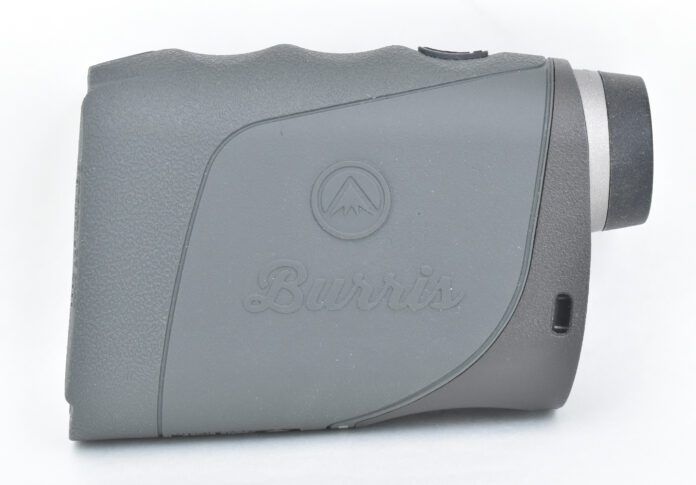We recently tested four of the longer-ranging laser range finder (LRFs) products now available, two of which we covered in the July 2023 issue of magazine, and which are available to subscribers in the whole-issue PDF. Those LRFs were the SIG Sauer Kilo 4K, $599, and a Leupold RX-2800 TBR/W, also $599. At the same time, we tested two other units that we cover here only in Gun Tests+.
First was the Burris LRF 2000, $299, which has three ranging modes (Auto, Sport and Hunt). The Burris LRF claims a maximum ranging capability of 2400 yards.
Last was the just-released $499 Vortex Laser HD 4000 GB, with onboard environmental sensors and a stated max range of 2400 yards.
All four of these range finders have a stated maximum range of 2000 or more yards. Note that pointing these lasers where they might be shined in a human eye is absolutely prohibited, no matter if the box says “eye safe” or not. Strictly adhering to safety protocols, we opted to use buildings, signs, and other features at American Shooting Centers on a day the massive range was closed to the public. True to the tenets of modern engineering and marketing practices, most of these LRFs provides something unique in addition to the ability to range targets. Those capabilities are noted as well.
Our Houston test team has mentioned previously that we are persistent and vociferous adherents of a particular practice whose initials are RTM, especially when first employing a new piece of technology. The acronym associated with that practice translates to Read The Manual, and that is exactly what we needed to do with each of the four LRFs in our test. While not quite as complicated as Windows 11, these optics are capable of some astounding feats — more so if you read the instructions.
While there were a couple of targets that proved very difficult to obtain a reading on, overall we were very pleased with the distances we could obtain. We managed to isolate a portable toilet (yep, those are common fixtures at outdoor ranges) from behind a partial screen of trees at more than 700 yards. We obtained good hits on a very large flagpole at more than 1200 yards and stop signs at more than 1100 yards. There are, obviously, some differences in capabilities between the four range finders, but we would not hesitate to take any of these four into the field with us. Here are more details on the Burris and Vortex units.
Burris Signature LRF 2000, $299
Our Burris Signature LRF 2000 arrived ready to go. The box included the LRF, a CR2 battery, a case for the range finder that attaches nicely to a belt, a removable lanyard, and instructions. Dimensions for the unit are 4.75 by 3.25 by 1.5 inches, and the other three units are approximately the same size.
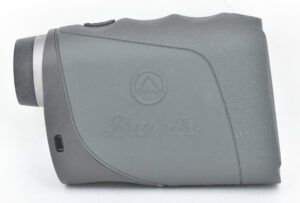
Standard features for the Burris LRF 2000 include a rubber-armored outer surface, an adjustable diopter, and what is rated as an eye-safe laser. The manual also states specifically that the laser should never be pointed at a human eye, nor should it be left lying around where children could play with them.
The Burris allows the user to range via several different modes: Auto will display the range of the target with the strongest signal; Sports mode displays the range to the closest target in a group; and Hunt mode shows the furthest range in a group of targets. The Hunt mode could be very useful when trying to range an animal through surrounding trees or grass. Of course, ranges can be expressed in yards or meters, with yards being the default. Mode selection is simple — turn the power on using the “Range” button on top, and then depress the “Mode” button on the side for 2 seconds to activate.
The Burris offers five display options:
- LOS — Line of sight only – distance from the laser to the target.
- HOR — Horizontal – the horizontal distance across the ground. On flat terrain, LOS and HOR should read the same. The difference comes when angles are introduced, and the HOR range will be shorter. When hunting in hills or mountains, the horizontal distance is what matters, even when elevation changes are required for the shot.
- LOS and HOR – both readings will show, with the LOS shown as the upper number visible in the display.
- LOS and ANG – both Line of Sight and the shooting angle are shown. Many ballistics apps ask for the pure range and the angle, from which they compute the horizontal distance and the needed elevation adjustment.
- HOR and ANG – Horizontal distance and angle are shown.
The shooter can also choose between five settings for the brightness of the display.
Using the unit is simple; depress the range button on top to power on. Center the object to be ranged in the circle, and hit the range button again, then release for a single measurement. Hold the ranging button down and the unit continuously ranges for a moving target. The display will turn off after 10 seconds of no use. Battery life is estimated in number of ranges taken. The Burris claims a life sufficient for 2000 ranges.
The Burris LRF 2000 is fairly light at only 6 ounces. It sports a 7x magnification with a 25mm objective diameter. Field of View (FOV) at 100 yards 31.5 feet. Maximum angle is +/- 70 degrees.
We found that the Burris had a bit of difficulty in properly ranging a smaller object just offset and to the rear of a larger object. It also had a hard time ranging equipment and transmission towers that had a lattice-type construction. That said, it managed to get a range on a skinny little flagpole at more than 1240 yards, right along with the more expensive models.
Our Team Said: When assessing the range-finding capabilities of the Burris LRF 2000 (and within our safety-imposed limitations), this Burris LRF seemed to be able to deliver 90%+ of the mechanical capabilities of the other LRFs tested at half the price, thereby earning our selection of it as a Best Buy.
Gun Tests Grade: B (Best Buy)
$499
Those familiar with Vortex Optics will know that the Razor series is their top-of-the-line brand, regardless of whether it is for riflescopes, binoculars, red dots, or spotting scopes. That title also designates their high-end laser range finder. As such, the Razor HD 4000 comes with some serious bells and whistles.
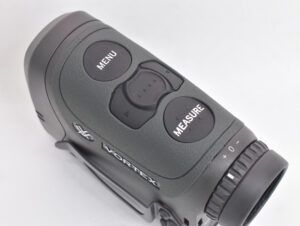
Once again, we have a manual, and you have to love that. The LRF comes in what looks more like a good glasses case than a simple carry case for a range finder. It is a bit larger and a bit sturdier than the others we’ve handled. It also sports a piece on the back to allow easy attachment to MOLLE gear. For those who prefer a smaller package for carry, the Razor 4000 HD comes with a belt clip that is reversible via the removal and reattachment of three Allen screws. The CR2 battery is included, as is a lanyard. This LRF has an eye cup that can be extended as necessary for use without glasses or contracted if the user is wearing eye protection or corrective lenses. As with the SIG and the Leupold units, a tripod mount is included in the bottom of the range finder. Note that all of this gear comes at a cost. The Vortex Razor HD4000 GB is the heaviest of the four units tested at 10.1 ounces. The Burris LRF 2000 is only 6 ounces. Both the SIG and the Leupold units weigh between 7 and 8 ounces.
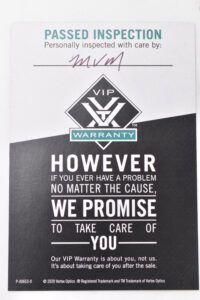
The Razor’s list of features is impressive:
- Onboard temperature and barometric pressure sensors.
- An adjustable eye cup to adjust for users with or without glasses.
- Normal (strongest signal), first, and last signal capture modes, as well as an extended-range mode.
- HCD (horizontal capture distance) mode, which displays true horizontal distance to the target, or BAL mode, which is used when linked to external devices.
- Range display in meters or yards, temperature in Fahrenheit or Celsius.
- Single range or continuous scan.
- The ability to adjust for wind direction and speed on the fly, directly from controls on the unit.
Three of the four LRFs tested had the Mode button located on the side of the unit. The Vortex Razor puts that button on the top – along with three other buttons besides the range tab – and all were easy to find and operate. Options for brightness of display, units of measure for temp and barometric pressure, along with auto-shutoff time settings are easily found and changed. Those other three buttons allow the user to capture wind direction as well as change estimated wind speed, all with the press of a finger.
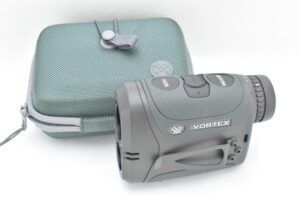
Even with substantial existing capabilities, the ability to add to external devices (as is also the case with the SIG Kilo 4K) adds a great deal more. Vortex announced their partnering with GeoBallistics in April 2023. The Razor HD 4000 GB can sync with the GeoBallistics app, allowing custom rifle/ammo profiles to be uploaded to their range finder. The Razor HD 4000 GB can connect with Android or iPhones, as well as Kestrel or Garmin environmental devices individually or in tandem. The result is a wealth of information available to the user. All of this data culminates with specific elevation and windage adjustments that can be viewed in the Vortex LRF.
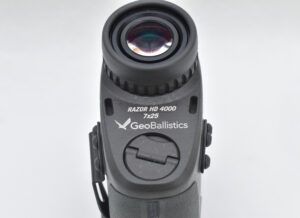
We found the accuracy and the ease of operation for the Razor HD 4000 GB to be very similar to that of the SIG Kilo 4K and the Leupold RX-2800, while slightly superior to the Burris. The center circle of the reticle for the Vortex is a bit larger than the others, and we actually prefer the smaller aiming point. For our needs, we thought the software on the SIG and Vortex models gave them an edge over the Leupold. Depending on the user’s preferences, however, the less complicated software for the Leupold unit might be a definite plus. To our eyes, the display font on the Vortex was not solid or, perhaps, completely filled. The information was easy to see but tended to bloom just a bit.
Two other things sold us on the Vortex as our top choice. The first is, all of the controls being on top of the unit where they were easily reached and manipulated (and the ability they brought to adjust wind data). The second is the warranty. Vortex guarantees their range finder forever, no questions asked (as does Burris). We don’t see that very often on electronic devices.
Our Team Said: If the shooter wants all the functionality he can get from a range finder, he may want to look at the Vortex Razor HD 4000 GB. With great optics, onboard environmental sensors, and the ability to link to your phone, Kestrels and more, the Vortex Razor HD 4000 is quite the package.
Grade A- Our Pick
Ranging Test
| Brand | Sig Sauer | Leupold | Burris | Vortex |
| Model | Kilo 4K | RX-2800 | LRF 2000 | Razor HD 4000 GB |
| Object Lased | ||||
| From Location A | ||||
| Storage Building | 335.2 | 335 | 335 | 335 |
| Trash Can | 347.9 | 347 | 338** | 348 |
| Stop Sign | 706.9 | 704 | 704.5 | 705 |
| County Building | 716.8 | 716 | 716.3 | 713 |
| Shooting Station | 434.8 | 431 | 431.7 | 431 |
| Portable Toilet | 700.4 | 698 | 698 | 698 |
| Dove Tower | 626.6 | 622 | 622.29999999999995 | 623 |
| From Location B | ||||
| Storage Building | 733 | 732 | 733 | 733 |
| Portable Toilet | 739.7 | 735 | 733** | 738 |
| Stop Sign | 1104 | 1101 | 1102 | 1104 |
| Transmission Tower | 846 | 842 | X | 843.2 |
| From Location C | ||||
| 20x30” Torso Plate | 440 | 448 | 440 | 448 |
| 45% IPSC Plate at 510 YDS | X* | X* | X* | X* |
| Mule Deer Metal Cutout | 623 | 624.20000000000005 | 629 | 626 |
| From Location D | ||||
| Flagpole | 1246 | 1244 | 1241 | 1243 |
| Dove Tower | 959 | 955 | 955 | 956 |
| Lattice Tower | 839.7 | 836 | X | 834 |
*None of the LRFs could see this plate
**The Burris could not find the right target sitting next to the larger building.
Laser Range Finder Comparison Chart
| Brand | Burris | Sig Sauer | Leupold | Vortex |
|---|---|---|---|---|
| Model | LRF 2000 | Kilo 4K | RX-2800 | Razor HD 4000 GB |
| Magnification | 7x | 6x | 7x | 7x |
| FOV @ 100 Yds | 31.5 Ft. | 31.4 Ft. | 31.8 Ft. | 34.1 Ft. |
| Range Maximum | 2000 yards | 4000 yards | 2800 yards | 2400 yards |
| Range Reflective – Trees | 1600 yards | 2000 yards | 1300 yards | 1800 yards |
| Range – Deer | 1100 yards | 1600 yards | 1100 yards | 1600 yards |
| Weight | 6 oz. | 7.25 oz. | 7.9 oz. | 10.1 oz. |
| Objective Aperture | 25mm | 22mm | 27mm | 25mm |
| Battery | CR2 | CR123 | CR123 | CR2 |
| Dimensions | 4.75x3.25x1.5 in. | 4x3.1x1.5 in. | 4.4x2.9x1.5 in. | 4.4x3.2x1.9 in. |
| Battery Life, Number of Ranges | 2000 | 4000 | 4000 | 2000 |
| Software | NA | Applied Ballistics Light | Sierra Infinity | GeoBallistics |
| Price | $299 | $599 | $599 | $499 |
| Warranty | Forever | 5 year limited | 2 years | Forever, unlimited |
| Gun Tests Grade | B (Best Buy) | A | A- | A- (Our Pick) |

























